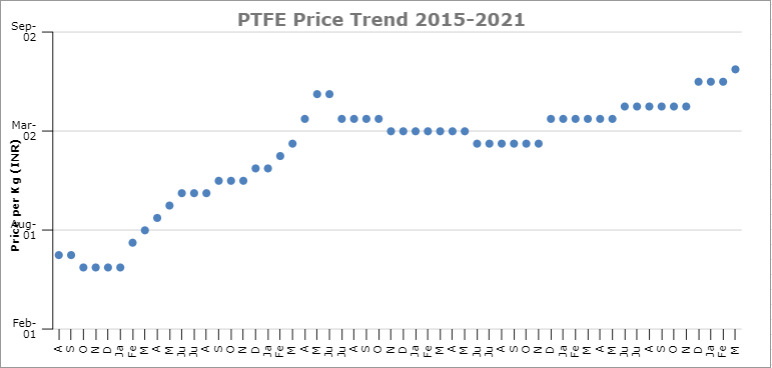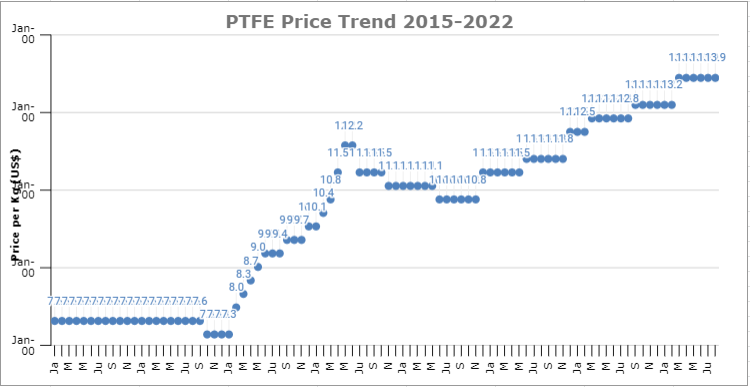The growth of the oil & gas industry has been one of the cornerstones of the industrial boom over the past century. While the processes of extraction, storage, refining, and distribution have all been in place for a while, the technologies in the background have continued to evolve. Further, as new and improved methods were developed, they have required the use of special materials to be incorporated.
The polymer industry has always been closely connected to oil & gas by virtue of the fact that many polymers are derived as by-products of the oil refining process. The supply and pricing of polymers such and polyethylene and polypropylene move almost in tandem with oil prices as a result. However, these base polymers are rarely the ones used in oil & gas equipment. The presence of corrosive chemicals, high-temperatures, and rough handling necessitates the use of high-performance plastics.
Polymers such as PTFE, PEEK, and PPS are especially useful because they are able to withstand multiple forces and require minimal maintenance. This means that they can be installed in equipment deep within a system and it is assured that they would not need to be constantly checked on.
Considering PTFE, PEEK, and PPS are all stable up to temperatures of 260°C, they are invaluable in oil & gas applications.
PTFE and PEEK Packing Rings
Packing rings, V-rings, V-packings or Chevron Packings are commonly used in oil extraction equipment. These components are usually made with PTFE, PEEK, or PPS and incorporate a carbon filling for added wear properties. Chevron rings are usually made to be stacked one above the other and then fitted as a single element around a metal shaft. The rings protect the shaft from wear and are themselves resistant to the gases and heat that the shaft will also experience.
Given that the rings are machined with v-grooves and that they need to fit into one another perfectly, not all manufacturers are able to make such components. Care needs to be given to tolerances, which can be as low as 2 microns, to ensure a fit. Further, special attention needs to be given on the blending of carbon, as this needs to be uniform if the part is to have a life of 10-15 years, as required.
Sealing Rings and Gaskets
Sealing rings and gaskets are especially useful in high-pressure environments. Not only does the oil & gas process involve corrosive chemicals at high temperatures, but the pressures at which these push their way through the system can be highly erratic.
Sealing rings and gaskets – usually made with PTFE or a PTFE+PPS blend – need to be soft enough to create an adequate seal, but hardy enough to take high pressures without deforming.
Sealing rings are normally used in metal-to-metal joints and should be able to take pressures in excess of 100 Bar. They are integral in ensuring that the system does not leak and/or lose pressure – both of which can have highly adverse effects.
Valves, seats, and conduits
Polymer valves – such as butterfly valves, ball-valves, or even specialized valves and conduits – are vital to managing flow within a system. The liquids or gases within these systems can corrode even robust materials like stainless steel. PTFE and PEEK are often used as ball-valve-seats, while PTFE and PPS can also be machined to make special valves and t-joints to ensure that the system is not eaten away over time by the chemicals present.
PTFE Pipe Lining
PTFE pipe lining is a common process to ensure that large pipes – usually made using mild steel – are kept protected from corrosion. The PTFE is first extruded as a pipe with a wall thickness of 2.5-4mm and this is then drawn into the mild-steel pipe using a hydraulic press to create a uniform layer inside the steel pipe. The layer of PTFE within the mild steel ensures that the metal is totally protected. Such lined pipes are essential to create a piping system that can survive years, or even decades without getting corroded or developing leaks.
PTFE Sliding bearings
While the primary purpose of polymers is to protect and create efficiencies within fluid systems, PTFE also finds application in the bearings that allow oil & gas pipelines to stretch across vast distances. The sliding bearing is made using a layer of PTFE and sits under the pipe support. The purpose of the bearing is two-fold. First, it allows for compressive loads to act upon it. The high compressive strength of the PTFE is needed for this. More importantly, PTFE’s low coefficient of friction allows for a sliding movement. This movement is crucial since a metal pipeline will experience tremendous thermal expansion and contraction during the course of a single day. The sliding movement of the bearing allows for this and ensures that no stress develops under the pipe supports that may lead to pipes being damaged or the supports collapsing.
PTFE Tubes
No fluid system is complete without the incorporation of PTFE tubes. Like lined pipes, the tubes allow for the passage of fluids without succumbing to corrosion or fracturing under high pressure. PTFE tube is expensive, so its use is mainly restricted to areas where it is absolutely necessary.
Certain applications – such a labs and research set ups – will use PTFE umbilical cords to transport gases from the refining process and to the labs for testing. The composition of these gases tells us whether the refining process is producing the right results. Since the gases cannot react with anything else before they reach the lab, PTFE is used. Typically, there will be 12-15 different separate gases to collect, so the cord is composed of a bundle of tubes, each at least 200-500 meters long.
Sealing materials
Beyond sealing rings, various polymer sealing materials are also incorporated into oil & gas systems. A key product is ePTFE (expanded PTFE) gasket tape. This is a soft, highly compressible tape made using pure PTFE. As such, it has all of PTFE’s properties, with the added benefit of being up to 65% compressible.
ePTFE tape can be made from anywhere as low as 0.2mm to as high as 15mm thick. In effect, the tape can be laid between two metal components and the system tightened to ensure that the gap between the two metals is completely sealed. A typical flange-to-flange connection can be installed using expanded PTFE and will stay perfectly sealed for years on end.
Again, like PTFE, the tape can withstand high temperatures and pressures of up to 100 Bar, making it a vital product in any fluid system.
Specialized components
Over the years, Poly Fluoro has had the opportunity to develop multiple specialized systems and components for the oil and gas industry. From special molding frames using PTFE+Glass, measuring and analysis chambers using a combination of PTFE, PVC, and acrylic, and even heat exchanger assemblies for chemical baths. Our expertise in machining, forming, extruding, and molding high-performance polymers allows us to understand the problems from first principles and identify the right polymer needed for the application.
Read More
1. High Performance Polymers in Railway Applications
2. Polymer Sealing Solutions – High Performance Seals, Valves, and Seats





